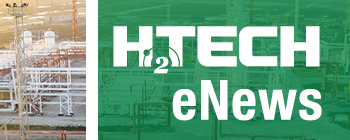News
Haffner Energy unveils Hynoca Flex 500 IG: A flexible, cost-effective alternative to gray H2 and fossil fuels
Haffner Energy introduced Hynoca Flex 500 IG, a line of H2 production units capable of producing 12 tons of green H2 per day to be delivered under €3/kg without subsidies. Hynoca Flex 500 IG also enables the production of cost-competitive renewable electricity to manage fluctuations in H2 demand or ensure energy autonomy.
“The expectations for H2 are extremely high, but they remain significantly constrained by the chicken-and-egg problem and the high cost of green H2 production,” said Philippe Haffner, Co-founder and CEO of Haffner Energy. “Our Hynoca Flex 500 IG solution simultaneously addresses both challenges, in a market worth over €100 billion worldwide. This is a major milestone for our company, which is expected to have a significant impact on our 2025 results, and which should also enable us to build up our order book for the coming years. More generally, it’s clearly a major paradigm shift for the global H2 ecosystem.”
Thanks to existing subsidies, grants or tax credits available in most developed countries, green H2 is now clearly cost-competitive with grey (fossil-based) H2, while providing much more flexibility and bringing a carbon-free solution. Not only does H2 and electricity cogeneration provide a unique solution for managing fluctuating H2 demand, it can also ensure energy autonomy of the system or even create opportunities in off-grid locations.
A major breakthrough for the H2 market. With unmatched flexibility, optimized energy efficiency (80%), and near-independence from power grids, Hynoca Flex 500 IG emerges as a scalable decentralized alternative to grey H2 and fossil fuels. The technology is modular and standardized, which ensures reliable and replicable deployment at scale. Available worldwide, the first units can be reserved starting today, with commissioning of the first units early 2027.
A significant EBITDA contribution starting this year. Hynoca Flex 500 IG is expected to make a significant contribution to Haffner Energy’s revenue – and above all to its EBITDA – for the current fiscal year, notably through paying engineering studies. The company reiterates its objective to reach EBITDA breakeven by March 31, 2026.
Cost-effective, modular green H2. Hynoca Flex 500 IG combines performance and modularity to meet industrial and mobility needs:
- Flexible production, requiring minimal or no grid dependency
- Optimization of CAPEX and OPEX, ensuring that H2 can be commercialized under €3/kg without subsidies Over 80% energy efficiency, maximizing process performance
- Rapid deployment, free from grid infrastructure constraints
- Standardized design, ensuring predictable performance and simplified integration.
A syngas with unmatched competitiveness. Hynoca Flex 500 IG generates highly competitive syngas, the precursor to H2. Its low cost opens up new economic opportunities beyond H2 production.
- Profitable peak-hour electricity generation: The cost of syngas is so competitive that it enables power production during peak hours, making it an economically viable solution to balance H2 demand fluctuations.
- Operational security without rigid contracts: This flexibility allows plant operators to maintain stable production without requiring rigid offtake agreements.
By combining H2 and electricity generation, Hynoca® Flex 500 IG ensures continuous operation, optimizing revenue streams and enhancing economic resilience, making final investment decisions (FID) easier.
A strategic complement to electrolysis and power-to-liquid (PTL). Each Hynoca Flex 500 IG unit generates 58,000 tons of biogenic CO₂ per year, a key resource for PTL (eFuels) production and a critical enabler for H2 from electrolysis.
- 58,000 tons of renewable CO₂ can convert 5,230 tons of H2 into 42,000 tons of eMethanol (or 18,000 tons of eSAF), easy to transport and store
- 5,230 tons of H2 is the volume produced each year by 60-MW of electrolyzer capacity (4,000 hours/year load factor)
- Strategic synergy between Hynoca Flex 500 IG and electrolysis plants, structuring the H2
Hynoca Flex 500 IG not only delivers competitive H2, but it also supports the expansion of electrolysis by providing a reliable source of competitive biogenic CO2.
Proven, standardized technology for industrial scale deployment. Hynoca Flex 500 IG builds on Hynoca technology, already operational at the Center for H2 production, testing and training in Marolles, France. This unit has been producing H2 that meets mobility standards.
Scaling up this technology ensures industrial continuity with no technical risks, optimizing implementation for large-scale projects.
Hynoca process accepts all possible organic renewable feedstocks, including agricultural residues, sludge, manure, municipal sorted waste, and woody by-products, supporting a circular, low-carbon economy with a near-zero carbon footprint. Compatibility with all organic feedstocks means considerably lower costs, while at the same time significantly improving security of supply.
Each Hynoca Flex 500 IG unit consumes approximately 31,000 tons of dry plant-based biomass per year.
Reservations system to manage market demand. A recent market survey conducted by Haffner Energy indicates that demand for Hynoca Flex 500 IG will far exceed the company’s current industrial and commercial capacity.
To structure production and ensure timely deployment, a reservations system is currently being prepared and will open in 2025 Q3. In the meanwhile, requests for quotations can be made to the company in advance.
Reservations, which will involve the payment of an upfront fee, constitute a win/win system for the company and its customers, allowing in particular:
- Guarantee that customers will be served in the face of demand that is expected to far exceed supply
- Secure delivery timelines and fixed pricing
- Substantial savings on typical final investment decision (FID) costs
- Assistance with feedstock sourcing plans.
This system prioritizes committed clients while allowing flexibility for project development, helping to align industrial production capacity with actual market needs.

